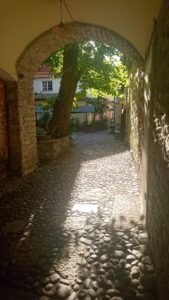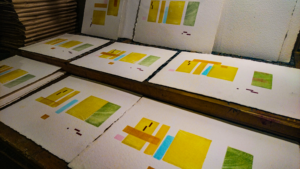During my studies in Interior Design at a German university, I often felt like anything which didn’t involve a computer was not very popular amongst the students. At the start of a project you had to do some hand sketching and build models, but most students tried to switch to CAD programmes as soon as possible. Our professors kept trying to make us work with our hands and a piece of paper, saying that creativity needs free space, uncertainty and coincidence – all of which you can’t really get whilst working with a very precise and complex programme.
Last year in winter I decided that I needed a change of perspective and find new ways to be creative. To get away from the bright monitor and experience the Design process from a different angle. Fortunately, I found the perfect place for that.
 At Labora, you don’t need to speak the same language to do creative projects together and be inspired. Of course it does help to be able to clarify things with words, but you can also evolve projects by making weird noises and gestures to explain it – in most cases, at least.
At Labora, you don’t need to speak the same language to do creative projects together and be inspired. Of course it does help to be able to clarify things with words, but you can also evolve projects by making weird noises and gestures to explain it – in most cases, at least.
The hardest part was choosing what to do. Apart from some tasks that needed to be done – like making deliveries or packing the beautiful products – I could freely plan my day. The first few weeks I was quite busy editing illustrations and calligraphy for the Red Book of Endangered Species: Estonia, helping with the layout and taking photographs.
After that, I had to decide. Do I want to help in the woodworking workshop, experiment with papermaking, learn how to print on an old letterpress or practice calligraphy? Or do I want to make something completely different?
I tried out all of these things, asked a lot of questions and had a lot of ideas for my art project, as time kept running past me.
With not very many of my 61 days left, I finally started to work more concentratedly on my project. I wanted to try and catch a glimpse of the emotions I had during my stay, making them visible to others. As it was exceptionally hot and sunny, the house facades were shining in vivid colours, complementing the unique architecture. Mostly made out of traditionally used materials – wood and limestone – they were radiating a sense of joy and easiness.
Equipped with a colour fan I ventured through Tallinn, finding some distinct houses and their colour.
I then mixed these colours accordingly, one after the other. This process took the whole day, as I always had to mix a single colour, print it on the seven handmade papers and clean everything. Only then could I mix the next one.The result was a simplification of Tallinn facades showing a wooden structure, with dark red elements representing the common red window frames and doors.
Now, two months after my experience in Estonia, I feel very lucky thinking about it. All of the people I met – some of which I now count as good friends – have helped me to evolve personally and professionally and to appreciate the importance of traditional techniques. Combining these with technological advances can lead to a much more thoughtful, emotional Design.
»The word traditional was used as though
it meant harking back to the past.
It meant the opposite – trado, I carry –
and therefore implies that which is carried forward;
that which is considered worthy of carrying forward;
that which is too valuable to throw away.«
Beatrice Ward (1900 – 1969)
Text and photos by Carina Feder.



